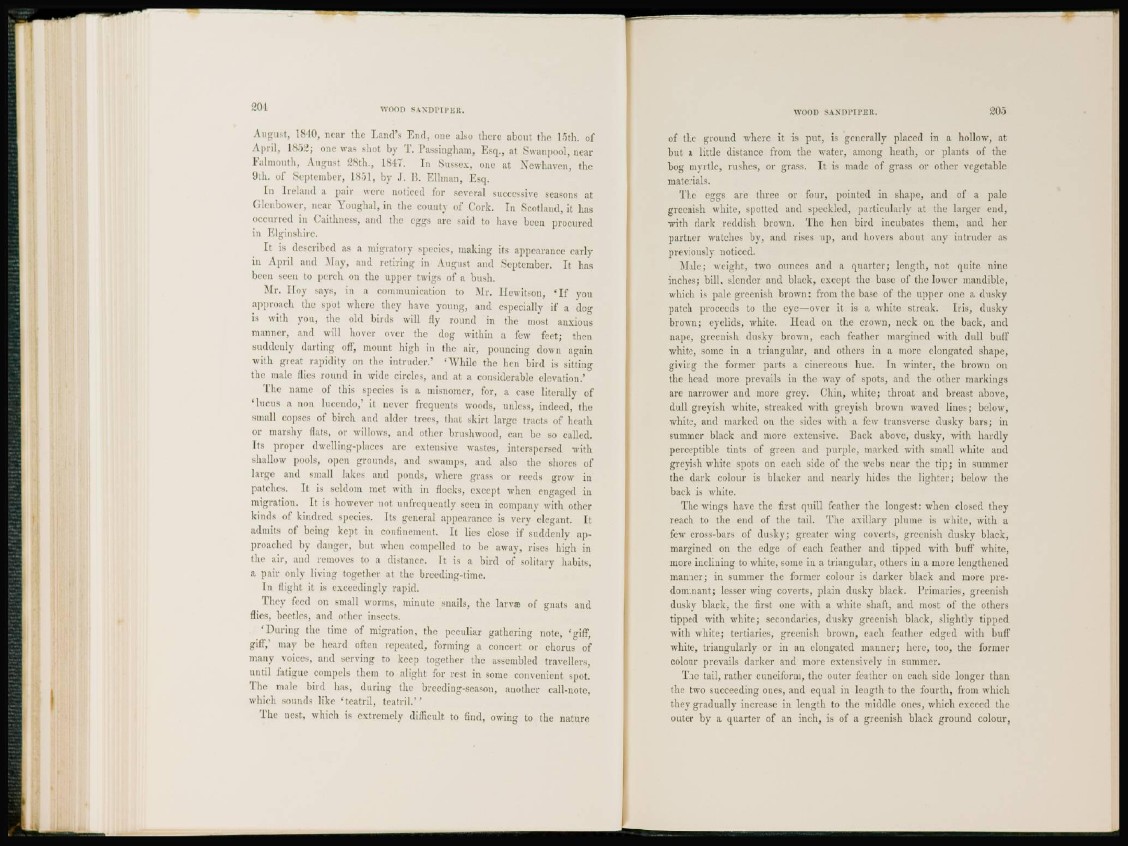
204 "Woon SANDPIPER.
August, 1840, near the Land's End, one also there about the 15th. of
April, 1852; one was shot by T. Passingham, Esq., at Swanpool, near
Pal mouth, August 28th., 1847. In Sussex, one at Newhaven, the
9th. of September, 1801, by J. B. Ellman, Esq.
In Ireland a pair were noticed for several successive seasons at
Glenbower, near Youghal, in the county of Cork. In Scotland, it has
occurred in Caithness, and the eggs are said to have been procured
in Elginshire.
I t is described as a migratory species, making its appearance carly
in April and May, and retiring in August and September. It has
been soon to [torch on the upper twigs of a bush.
Mr. Hoy says, in a communication to Mr. Hewitson, ' I f you
approach the spot where they have young, and especially if a dog
is with you, the old birds will fly round in the most anxious
manner, and will hover over the dog within a few feet; then
suddenly darting off, mount high in the air, pouncing down again
with great rapidity on the intruder.' 'AVhile the hen bird is sitting
the male (lies round in wide circles, and at. a considerable elevation.'
The name of this species is a misnomer, for, a case literally of
'Incus a non lucendo,' it never frequents woods, unless, indeed, the
small copses of birch and alder trees, that skirt large tracts of heath
or marshy flats, or willows, and other brushwood, can be so called.
Its proper dwelling-places are extensive wastes, interspersed with
shallow pools, open grounds, and swamps, and also the shores of
large anil small lakes and ponds, where grass or reeds grow in
patches. It is seldom met with in Hocks, except when engaged in
migration. It is however not unfrequently seen in company with other
kinds of kindred species. Its general appearance is very elegant. It
admits of being kept in confinement. It lies close if suddenly approached
by danger, but when compelled to be away, rises high in
t h e air, and removes to a distance. It is a bird of solitary habits,
a pair only living together af the breeding-time.
In flight it is exceedingly rapid.
They feed on small worms, minute snails, the larva? of gnats and
flies, beetles, and other insects.
' D u r i n g the time of migration, the peculiar gathering note, 'giff,
giff,' may be heard often repeated, forming a concert or chorus of
many voices, and serving to keep together the assembled travellers,
until fatigue compels them to alight for rest in some convenient spot.
The male bird has, during the breeding-season, another call-note,
which sounds like ' teatril, teatril.*'
The nest, which is extremely difficult to find, owing to the nature
WOOD SANDPIPER. £05
of the ground where it is put, is generally placed in a hollow, at
but a little distance from the water, among heath, or plants of the
bog myrtle, rushes, or grass. It is made of grass or other vegetable
materials.
The eggs are three or four, pointed in shape, and of a pale
greenish white, spotted and speckled, particularly at the larger end,
with dark reddish brown. The hen bird incubates them, and her
partner watches by, and rises up, and hovers about any intruder as
previously noticed.
Male; weight, two ounces and a quarter; length, not quite nine
inches; bill, slender and black, except the base of the lower mandible,
which is pale greenish brown: from the base of the upper one a dusky
patch proceeds to the eye—over it is a white streak. Iris, dusky
brown; eyelids, white. Head on the crown, neck on the back, and
nape, greenish dusky brown, each feather margined with dull buff
white, some in a triangular, and others in a more elongated shape,
giving the former parts a cinereous hue. In winter, the brown on
the head more prevails in the way of spots, and the other markings
are narrower and more grey. Chin, white; throat and breast above,
dull greyish white, streaked with greyish brown waved lines; below,
white, and marked on the sides with a few transverse dusky bars; in
summer black and more extensive. Pack above, dusky, with hardly
perceptible tints of green and purple, marked with small white and
greyish white spots on each side of the webs near the t i p ; in summer
the dark colour is blacker and nearly hides the lighter; below the
back is wdiite.
The wings have the first quill feather the longest: when closed they
reach to the end of the tail. The axillary plume is white, with a
few cross-bars of dusky; greater wing coverts, greenish dusky black,
margined on the edge of each feather and tipped with buff white,
more inclining to white, some in a triangular, others in a more lengthened
manner; in summer the former colour is darker black and more predominant;
lesser wing coverts, plain dusky black. Primaries, greenish
dusky black, the first one with a white shaft, and most of the others
tipped with white; secondaries, dusky greenish black, slightly tipped
with white; tertiaries, greenish brown, each feather edged with buff
white, triangularly or in an elongated manner; here, too, the former
colour prevails darker and more extensively in summer.
The tail, rather cuneiform, the outer feather on each side longer than
the two succeeding ones, and equal in length to the fourth, from which
they gradually increase in length to the middle ones, which exceed the
outer by a quarter of an inch, is of a greenish black ground colour,